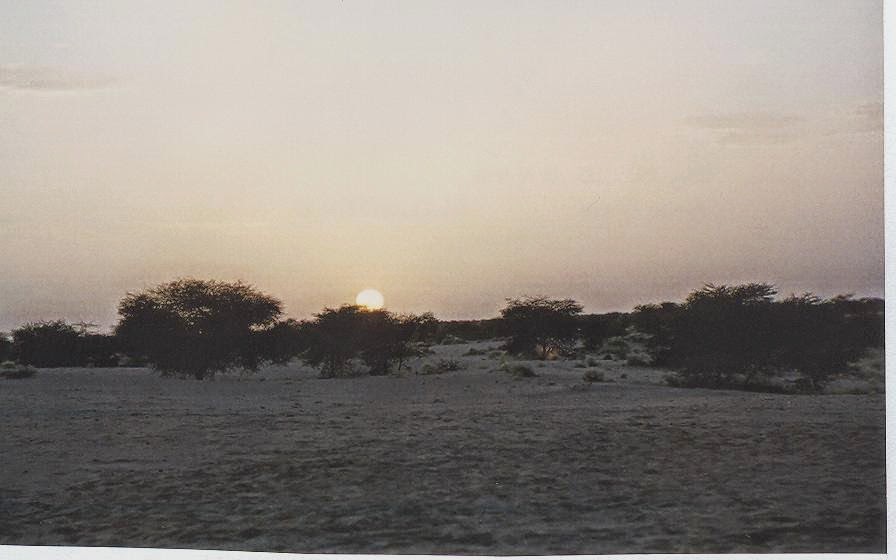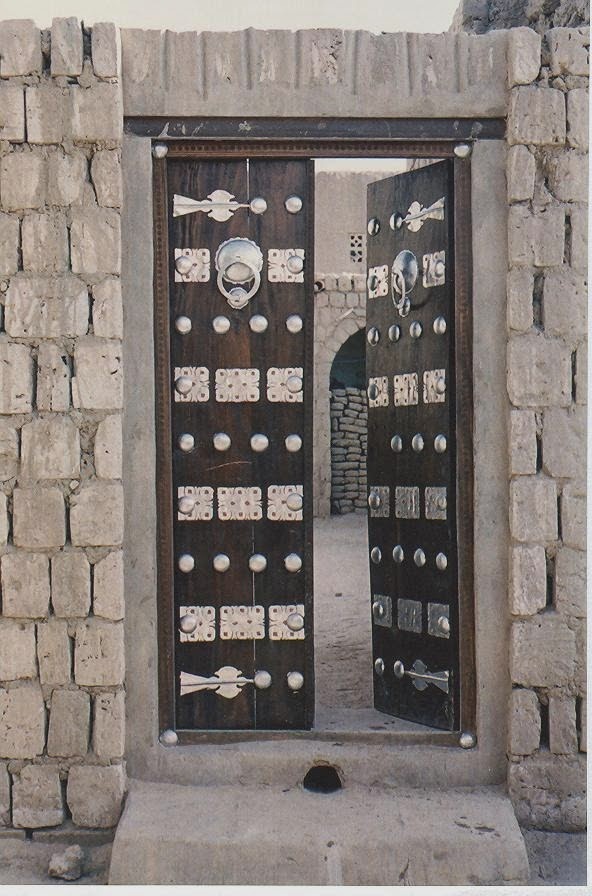Everybody has heard the name Timbuktu through the saying ''from here to Timbuktu'' meaning a place in the middle of nowhere, but quite a number of people do not know it is actually a real place even though in the middle of nowhere, surrounded by lots of nothing. Once located on the river Niger, today 20 km from the river since the Sahara has spread, and at the terminus of the great trans-Sahara caravan route, Timbuktu became extremely wealthy in the 13th to 16th centuries. Loaded with blocks of salt (mines are 1850 km away) and other goods, huge convoys of camel would spend weeks crossing the Sahara to reach the city. It was here that salt was traded with African merchants bringing gold and ivory along the Niger from the heart of Africa. Timbuktu became not only an important commercial center but also an important seat of learning and religion. The city had three universities and 180 Koranic schools. Books were not only written in Timbuktu but imported and copied and libraries contained unparalleled scholarly work. Today what remains of those are 130.000 Arabic-language manuscripts from the Middle-Ages, the Renaissance period and early Modern Times, covering a vast array of knowledge accumulated in this part of the World. But it is said that there are another 100.000 manuscripts stored in people's private homes. Everything is made today so that this important legacy to humanity does not vanish into dust. (Remember during the last al-Qaeda advance in Mali stopped by the French army, the jihadist zealots tried to burn the manuscripts).
Why is Timbuktu sometimes thought of as a myth ? At the height of its power, Timbuktu was fiercely Islamic and non-Muslims were totally banned from entering it , this only adding to its mystique. Several European researchers tried to reach Timbuktu disguised in Arab attires, but never returned. No wonder Timbuktu gained a reputation for being remote and impossible to reach, and thus became a byword for the middle of nowhere. That is the whole point of the place, it's main appeal.
Today Timbuktu is an impoverished town but a UNESCO World Heritage site and only its reputation makes it a tourist attraction (though there were not so many around) since there is nothing spectacular going on. The main danger (apart from the jihadists) is the threat of desert sands which keep on advancing on the city. So it is a very isolated, dusty town, with sand for streets, sand for house floors, a bunch of brown mud buildings and a sweltering sun that bakes everything. And there is not much else except for remnants of the old days.
 |
| STREETS ARE LİTERALLY OF SAND |
 |
| DJİNGARAY BER MOSQUE AND UNİVERSİTY CONSTRUCTED İN 1327. |
 |
| THE WOODEN DOORS WİTH SİLVER PİECES AFFİXED TAKE MY BREATH AWAY. |
 |
| SOME OF THE MANUSCRİPTS ARE HERE, SOME İN MUSEUMS İN FRANCE. |
 |
| STREETS OF TİMBUKTU. YOU WALK ON SAND AMONG MUD WALLS. |
 |
| HOUSE OF THE FİRST FOREİGNER WHO MANAGED TO RETURN FROM TİMBUKTU İN 1828, THE FRENCHMAN RENE CAİLLE . AT THAT TİME TİMBUKTU HAD ALREADY LOST İTS İMPORTANCE. |
 |
| WE ARE AT OUR SECOND UNİVERSİTY, SİDİ YAHYA, BUİLT İN 1441. |
 |
| FOR SOMEONE LİKE ME WHO HAS A WEAK POİNT FOR BEAUTİFUL DOORS, I AM WELL SERVED HERE. |
 |
| BEAUTİFUL GİRLS COME OUT OF BEAUTİFUL DOORS. |
 |
| WE ARE İN THE STREETS OF TİMBUKTU AGAİN |
 |
| TO BE EATEN !!!!! |
 |
| AND OUR THİRD AND OLDEST UNİVERSİTY, SANKORE, BUİLT İN 989. IT HAD SPACE FOR 2.000 STUDENTS AND WAS THE BİGGEST İN THE ARABİC WORLD. |
 |
| THE İNHABİTANTS OF TİMBUKTU, THE TOUAREGS |
In the evening, the inevitable sunset in the desert awaits us. Some went to the spot on camel back, some like me who do not like camel rides, went by car. As Timbuktu isn't really in the Sahara but in the Sahel, the area of scrub land south of the desert itself, there were no sand dunes to be seen. To find the sand dunes, I was told you have to go a further 100 km. Too far. Let us settle for the Sahel. On the surface, the desert looks practically lifeless but for a few trees and some olive-green bushes that look too dry to be alive but which seem to grow quite happily in the sand. Then you start seeing signs of life as people wander through the desert their heads hidden by their turbans and their bodies by their flowing robes. And you realize those people live here. The distinctive domes of nomadic tents dot the horizon and herds of goats and donkeys wander through the dry plants. Believe me , people are not born equal at all. Some are born into this dry solitude and live all their life in sand, among dry scrubs. Some don't.
 |
| THE CAMELS WAİTİNG TO TAKE US TO OUR DESTİNATİON |
 |
| NOMADİC HOUSİNG |
 |
| NOMADİC WİFE |
 |
| AND NOMADİC CHİLDREN - SO DESTITUTE, SO HOPELESS. |
 |
| TOUAREG TEA İN THE DESERT |
 |
| WE RETURNED TO TİMBUKTU AFTER THE WORST SUNSET I HAVE EVER WİTNESSED. |
The next morning we are going to return to Mopti by car, crossing the desert. But before reaching the desert, we have to cross the Niger River by ferry. So we came to what is considered today the port of Timbuktu, namely Port de Korioume. Do not be swayed by the name of the place, it is one of the poorest and most desolate places I have seen in my life. As our ferry came on ''African Time'', i.e. with two hours delay, I had ample time to visit this so-called port.
 |
| LOCAL BOATS |
 |
| THE PİNASSE - THE BOAT CARRYİNG PASSENGERS ALONG THE RİVER. PEOPLE SPEND TWO-THREE DAYS ON THOSE BOATS İN PRETTY CRAMPED CONDİTİONS AND WİTH AN ARMY OF MOSQUİTOES ATTACKİNG AT NİGHT. |
 |
| A STOP İS USED TO WASH CLOTHES AND DİSHES. |
 |
| THE HAİR MODEL İS VERY İNGENİOUS |
 |
| A TRUCK CAME UNLOADİNG SLABS TO BE LOADED ON A BOAT. |
 |
| THEN I REALİZED THOSE SLABS WERE SALT. I HAD NEVER SEEN SALT İN THİS FROM. |
 |
| THE DESERT ROAD BACK TO MOPTİ. NOT A REAL DESERT İN FACT BUT A RED ROAD PAİNTİNG THE CAR RED, THE SUİTCASES RED, EVEN YOUR SKİN RED. |
 |
| TWO EUROPEAN TOUAREGS |
It was difficult to reach Timbuktu and it was difficult to come back from it. It really is in the middle of nowhere. Have I been carried away by Timbuktu ? No. But I am very happy to have seen this isolated place, a place whose isolation has always been its main appeal. After all, this is Timbuktu, a fabled city, a mirage, a reality or all of those. And here it does not take much imagination to travel back in time.
















No comments:
Post a Comment